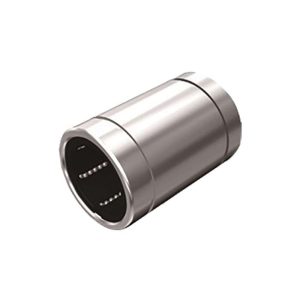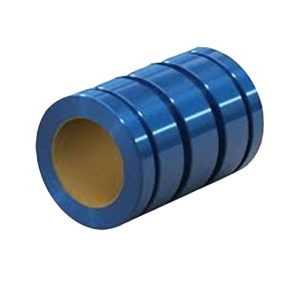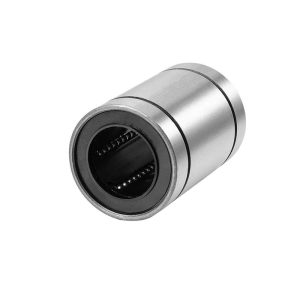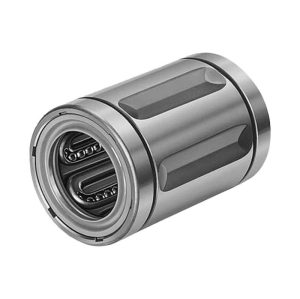Linear Bearings
Table of Contents
Definition of Linear Bearings
Linear bearings are mechanical components that facilitate linear motion and guide movement in a straight line, typically along a rail or track.

FHD Bearings is an ISO 9001:2015 certified manufacturing enterprise that stocks a full range of linear bearings. With over 1,200 different bearing sizes and over 250K bearings in stock.
Materials of Linear Bearings
Steel
Steel is a popular choice for linear bearings due to its strength and durability. Bearings made of steel are suitable for heavy-duty applications.
Stainless Steel
Stainless steel offers corrosion resistance, making it suitable for applications where exposure to moisture or corrosive substances is a concern.
Plastic/Polymer
Some linear bearings use plastic or polymer materials, such as PTFE (polytetrafluoroethylene) or nylon. These materials provide low friction, corrosion resistance, and can be suitable for applications where noise reduction is essential.

Aluminum
Aluminum bearings are lightweight and corrosion-resistant. They are often used in applications where weight is a critical factor.
Features of Linear Bearings

- Linear Motion: Linear bearings are specifically designed to facilitate motion in a straight line along a linear path, as opposed to the rotational motion of other types of bearings.
- Guidance Systems: Linear bearings often include integrated guidance systems, such as rails or tracks, to guide the linear motion with precision.
- Friction and Efficiency: Efficiency in linear motion is influenced by friction. Linear bearings are designed to minimize friction between moving parts, promoting smooth and energy-efficient operation.
- Material and Durability: The choice of materials, such as steel, stainless steel, or polymers, affects the durability of linear bearings. The selected materials should withstand the operating environment and provide long-lasting performance.
- Corrosion Resistance: Linear bearings may be exposed to harsh environments, including moisture and corrosive substances. Corrosion-resistant materials, such as stainless steel or specialized coatings, enhance the longevity of linear bearings in such conditions.
Advantages of Linear Bearings
- Smooth Motion: Linear bearings provide smooth and precise linear motion, crucial for applications requiring accurate positioning.
- High Precision: They offer high levels of precision, ensuring repeatability and accuracy in various industrial processes.
- High Load Capacity: Linear bearings can handle significant loads, making them suitable for both light-duty and heavy-duty applications.
- Low Maintenance: Many linear bearings require minimal maintenance, contributing to cost-effectiveness and reduced downtime.
- Customizability: Linear bearings come in various designs and sizes, allowing for customization to meet specific application requirements.

Taxonomy of Linear Bearings
Linear Bearings

Linear Ball Bearings
Use ball bearings in debris-free environments and when speed is a necessity. They operate with less friction than sleeve bearings, so you can run them at higher speeds.

Linear Ball Bearings for Support Rail Shafts
Ball bearings create less friction than sleeve bearings, so they require less force to operate.

Linear Sleeve Bearings
Because they usually do not require lubrication, linear sleeve bearings outperform linear ball bearings in dirty environments.

Linear Sleeve Bearings for Support Rail Shafts
Sleeve bearings outperform ball bearings in dirty environments. Use them for low speed applications.

Linear Bearings for Spline Shafts
Grooved on the inside, these bearings rotate with your spline shaft as they move loads up and down its length.
Mounted Linear Bearings

Mounted Linear Sleeve Bearings
Virtually maintenance free, these bearings have slippery, chemical-resistant liners that don't require added lubrication.

Mounted Linear Sleeve Bearings for Support Rail Shafts
Virtually maintenance free, these bearings have slippery, chemical-resistant liners that don't require added lubrication.

Mounted Linear Ball Bearings
Choose ball bearings for debris-free environments and when speed is a necessity. They operate with less friction than sleeve bearings, so you can run them at higher speeds.

Mounted Linear Ball Bearings for Support Rail Shafts
Mount these bearings on a support rail shaft for applications requiring maximum rigidity.

Mounted Linear Bearings for Spline Shafts
Ready to mount on your linear motion spline shaft, these bearings come installed in a housing and have grooves that match up with the splines on your shaft.
Linear Bearing Housings

Linear Bearing Housings
Slide up to two linear ball or sleeve bearings into these housings and secure them with the included intemal retaining rings.
Applications of Linear Bearings

- Machine Tools: Linear bearings are widely used in machine tools such as milling machines, lathes, and grinders to facilitate smooth and precise linear motion for cutting, shaping, and finishing operations.
- Automotive Industry: Linear bearings are employed in automotive manufacturing for tasks like robotic welding, assembly lines, and automated inspection systems. They contribute to the efficient and accurate movement of components.
- Electronic Manufacturing: Linear bearings are integral to the manufacturing processes of electronic components and devices. They contribute to the precision and repeatability needed in tasks like printed circuit board (PCB) assembly and semiconductor production.
- Medical Equipment: Linear bearings are utilized in medical equipment such as CT scanners, MRI machines, and robotic surgical systems. They enable smooth and precise motion in these critical applications.
- Material Handling Systems: Linear bearings are employed in material handling equipment, such as conveyor systems and robotic arms, to facilitate the smooth and controlled movement of goods in warehouses, distribution centers, and manufacturing facilities.
Key Manufacturing Process of Linear Bearings
Machining of Components
The manufacturing process often begins with the machining of individual components, such as outer and inner raceways, cages, and rolling elements. Precision machining ensures the dimensional accuracy and quality of these parts.
Heat Treatment
After machining, certain components undergo heat treatment processes to enhance their mechanical properties. Heat treatment can improve hardness, toughness, and overall durability, ensuring that the bearings can withstand the loads and stresses they will encounter during use.
Grinding of Raceways
The raceways, which are the tracks along which the rolling elements move, undergo precision grinding. Grinding is crucial for achieving smooth and precisely shaped raceways, ensuring minimal friction and optimal contact between the rolling elements and the raceways.
Assembly
Once the individual components are machined and treated, they are assembled into the final linear bearing. This assembly process includes fitting the rolling elements into the raceways, adding cages for proper spacing, and assembling seals or shields as necessary.
Lubrication
Lubrication is a critical step in the manufacturing process to reduce friction and wear, ensuring smooth operation and a longer lifespan for the linear bearing. Different types of lubricants, such as grease or oil, may be applied depending on the application requirements.


FAQ - Frequently Asked Questions

A linear bearing is a component that allows for controlled linear motion of a load along a predetermined path. It reduces friction between moving parts, enabling smooth and precise movement.
Common types include ball bearings, roller bearings, plain bearings, and linear bushings. Each type has specific design features suitable for different applications.
Linear bearings provide precise motion, reduce friction, support high loads, and enhance the overall efficiency of linear motion systems.
Linear bearings find applications in various industries, including machine tools, automotive manufacturing, industrial automation, medical equipment, aerospace, electronic manufacturing, and material handling systems.
Linear bearings facilitate motion along a straight path, while traditional bearings primarily support rotational motion.
Ball bearings use balls to facilitate motion, while roller bearings use cylindrical or tapered rollers. Roller bearings often handle heavier loads but may sacrifice some precision.
Factors include load capacity, precision requirements, speed, environmental conditions, and the type of linear motion system.
Linear bearings are lubricated to reduce friction and wear. Lubrication methods include grease, oil, and maintenance-free options, depending on the application.
The lifespan depends on factors such as load, speed, and environmental conditions. Proper maintenance and lubrication can extend the lifespan.
Yes, linear bearings with corrosion-resistant materials or coatings are available for applications in corrosive environments.
Open linear bearings are exposed, while closed bearings have protective seals or shields. Closed bearings offer better protection against contaminants.
Linear bearings are typically installed by mounting them to a support structure using bolts or other fastening methods. Proper alignment is crucial for optimal performance.
Some linear bearings, such as recirculating ball bearings, are designed to handle both axial and radial loads. It depends on the specific type and design.
Preload is a controlled force applied to eliminate play or clearance in a linear bearing, ensuring better accuracy and reducing backlash.
Proper lubrication, precision manufacturing, and selecting suitable bearing types can help minimize noise in linear motion systems.
The coefficient of friction indicates the resistance to motion. Lower coefficients of friction contribute to smoother and more efficient linear motion.
Specialized linear bearings with heat-resistant materials or coatings can be used in high-temperature environments.
Static load rating refers to the maximum load a bearing can withstand at rest, while dynamic load rating is the maximum load it can handle in motion.
Common issues include misalignment, contamination, inadequate lubrication, and improper preload. Troubleshooting involves identifying and addressing these issues.
Yes, linear bearings can be used in vertical applications, but considerations such as load capacity and proper lubrication are crucial to prevent issues like premature wear and increased friction.
Installation and Maintenance
Installation
- Prepare the Mounting Surface: Ensure that the mounting surface is clean, flat, and free from any debris or contaminants. Properly align and secure the mounting surface to the support structure.
- Inspect the Linear Bearings: Before installation, carefully inspect the linear bearings for any damage or irregularities. Check for proper lubrication and ensure that all components are in good condition.
- Align the Linear Bearings: Align the linear bearings with the designated path of motion. Use precision tools to guarantee accurate alignment. Proper alignment prevents premature wear and ensures smooth motion.
- Secure the Bearings to the Mounting Surface: Attach the linear bearings securely to the mounting surface using appropriate fasteners (e.g., bolts or screws). Follow the manufacturer’s guidelines for torque specifications to avoid over-tightening or under-tightening.
- Apply Preload (if necessary): If the linear bearing requires preload for improved accuracy, carefully apply the specified amount of preload. Follow the manufacturer’s recommendations and guidelines to achieve the desired performance.
- Lubricate the Bearings: Apply the recommended lubricant to the linear bearings. Ensure proper coverage of all moving parts. Lubrication reduces friction, minimizes wear, and contributes to smoother motion. Follow the manufacturer’s guidelines for the type and amount of lubricant.
- Test the System: After installation, perform a test run of the linear bearing system. Check for any unusual noise, vibration, or resistance. Verify that the linear motion is smooth and meets the required specifications.
Maintenance:
- Rail Cleaning and Lubrication: Regularly clean and lubricate the linear guide rails. Accumulated dirt or debris on the rails can hinder smooth motion and increase friction. Use a suitable rail cleaner and apply the recommended lubricant to ensure optimal performance.
- Ball Screw Lubrication: If the linear system incorporates ball screws, follow a scheduled lubrication routine. Apply the specified lubricant to the ball screw assembly to reduce friction and enhance the efficiency of the linear motion.
- Seal and Cover Inspection: Check the seals and covers of the linear bearings for any damage or wear. These components protect the bearings from contaminants. Replace damaged seals and covers to maintain a clean and protected environment for the bearings.
- Preload Adjustment (if applicable): For linear bearings with preload settings, periodically check and adjust the preload as needed. Proper preload ensures the necessary contact between rolling elements and raceways, optimizing accuracy and reducing backlash.
- Cage Inspection: Inspect the cages of linear bearings for signs of wear or damage. The cage holds the rolling elements in position and ensures proper spacing. Damaged or misaligned cages can lead to uneven loading and premature wear.
- Temperature Monitoring: Regularly monitor the operating temperature of the linear bearing system. Excessive heat can be an indicator of insufficient lubrication or other issues. Address any temperature anomalies promptly to prevent damage and ensure optimal performance.

Related Posts
How Do Linear Bearings Work?
Table of Contents Categories How Do Linear Bearings Work? Introduction...
Read MoreEnhancing Performance: Key Tips For Linear Bearing Selection
Table of Contents Categories Enhancing Performance: Key Tips For Linear...
Read MoreThe Symphony of Silence: Noise Reduction in Linear Bearings
Table of Contents Categories The Symphony of Silence: Noise Reduction...
Read MoreGlide to Precision: Unveiling the Magic of Linear Bearings
Table of Contents Categories Glide to Precision: Unveiling the Magic...
Read More



